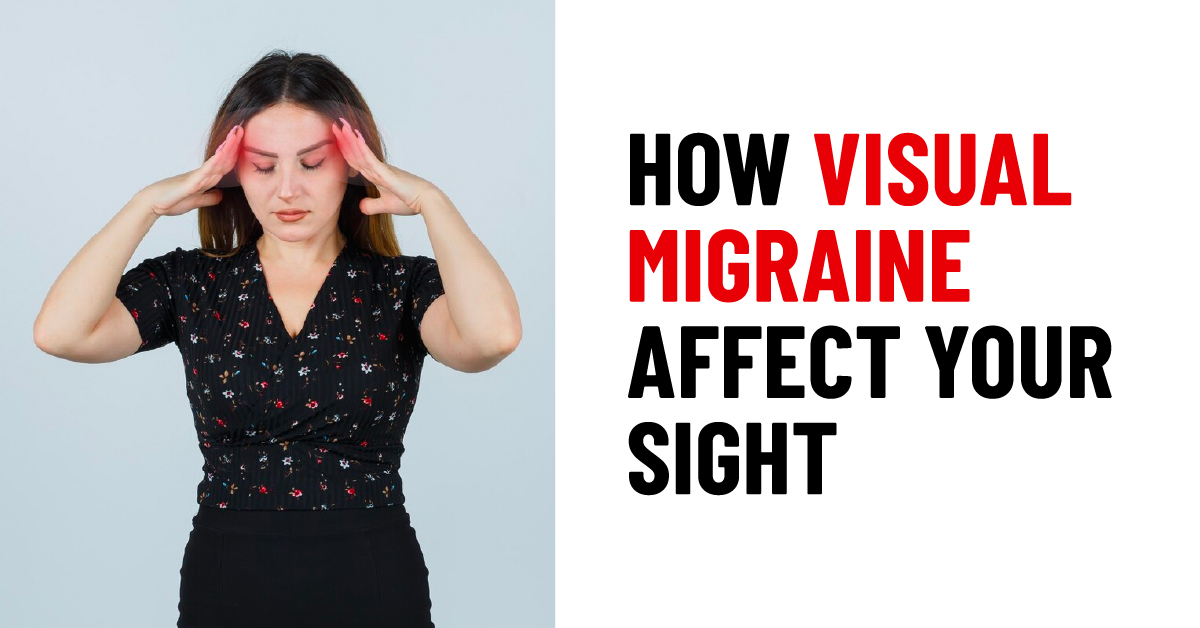How Visual Migraine Affect Your Sight – Migraines on Display

Also available in
Visual Migraine is also known as ocular migraine or migraine with aura. Migraine is a common neurological disorder that affects millions of people around the world. Visual Migraine is a type of migraine that involve visual symptoms such as flashing lights, zigzag lines, and blind spots. In this article, we will explore the causes, symptoms, and treatments of visual migraine, as well as provide tips for managing the condition.
What Is Visual Migraine?
Visual migraine is characterized by severe headache attacks, often accompanied by nausea, sensitivity to light and sound, and visual disturbances. During a visual migraine, a person may experience temporary vision loss, blurry or distorted vision, and flashes of light or zigzag lines. These symptoms can last for several minutes to an hour and are often followed by a headache, although in some cases, a headache may not occur.
Symptoms of Visual Migraine
- Blind spots or scotomas – areas of vision that are blocked or appear distorted
- Flashes of light or flickering lights – these can be white, black, or colored lights that flicker or flash in the vision
- Zigzag lines or wavy lines – these lines can move or appear stationary and are often described as looking like a castle turret or a squiggly line
- Blurry vision or difficulty focusing – objects may appear blurry or out of focus
- Temporary vision loss in one eye – some people may experience temporary loss of vision in one eye, which typically resolves within an hour
These visual symptoms usually occur before the onset of a headache and can last from a few minutes up to an hour.
What Causes A Visual Migraine?
The exact cause of this migraine is not fully understood. However, it is believed to be related to changes in blood flow and electrical activity in the brain.
During a visual migraine, blood vessels in the brain may constrict or dilate, leading to changes in blood flow and oxygen supply to the brain. This can trigger the release of chemicals that cause inflammation and irritation of the nerves, leading to visual disturbances.
It is thought that abnormal electrical activity in the brain can also contribute to visual migraines. This abnormal activity can stimulate the visual cortex of the brain, leading to visual disturbances that are characteristic of visual migraines.
Risk factors of Visual Migraine
There are several risk factors that can increase the likelihood of experiencing visual migraine or ocular migraine or migraine with aura. These risk factors include:
1. Genetics: It may have a hereditary component and if you have a family history of migraines, you may be more likely to experience them.
2. Hormonal changes: Fluctuations in hormones, particularly estrogen can trigger visual migraines in some people. This explains why a lot of women get migraines right before or right after their period.
3. Stress: Stress is a common trigger for many types of headaches, including visual migraines.
4. Certain medications: Some medications, such as birth control pills or medications for high blood pressure, can trigger visual migraines.
5. Environmental triggers: Certain environmental factors such as bright lights, loud noises, or strong smells can trigger visual migraines in some people.
6. Other medical conditions: Certain medical conditions such as stroke, epilepsy, or a history of head injury can increase the risk of experiencing visual migraines.
Treatment of Visual Migraine
The treatment of visual migraine typically involves a combination of lifestyle changes and medication to manage symptoms. Here are some common treatments for visual migraine:
1. Lifestyle changes: Identifying and avoiding triggers such as stress, bright lights or certain foods can help reduce the frequency and severity of visual migraines. Maintaining a regular sleep schedule, staying hydrated, and engaging in regular exercise can also be helpful.
2. Medications: Over-the-counter pain relievers such as ibuprofen or acetaminophen may be helpful in managing mild to moderate visual migraines. Prescription medications such as triptans or ergotamines may be prescribed for more severe migraines. These medications work by constricting blood vessels and reducing inflammation in the brain.
3. Biofeedback: Biofeedback techniques, which involve learning to control certain bodily functions such as heart rate and muscle tension, can be helpful in managing the symptoms of visual migraines.
4. Relaxation techniques: Practicing relaxation techniques such as deep breathing, meditation or yoga can help reduce stress and tension, which can trigger visual migraines.
It is important to work with a healthcare professional to develop a personalized treatment plan that is tailored to your specific needs and symptoms.
In addition, if you experience sudden or severe visual changes or have other symptoms such as weakness or difficulty speaking, you should seek immediate medical attention, as these could be signs of a more serious condition.
Visual Migraine and Stroke Risk
Visual migraine has been associated with a slightly increased risk of stroke. This is particularly true for people who experience frequent migraines with aura, have a family history of stroke, or have other risk factors for stroke, such as high blood pressure, smoking, or diabetes.
Migraines with aura are thought to increase stroke risk because the visual disturbances and other symptoms associated with aura may be caused by changes in blood flow to the brain. These changes may also increase the risk of blood clots, which can lead to a stroke.
It is important to note, however, that the overall risk of stroke associated with visual migraines is still relatively low. Most people who experience visual migraines do not go on to develop a stroke.
Nonetheless, it is important to work with a healthcare professional to manage your visual migraines and reduce any risk factors for stroke.
CONCLUSION
Visual migraine is generally not a serious medical condition. It is important to speak with a healthcare professional if you experience visual migraines to rule out any underlying medical conditions and to develop an effective treatment plan.
People who experience frequent migraines with aura or have other risk factors for stroke should be aware of the slightly increased risk of stroke associated with visual migraine and work with their healthcare professional to manage this risk.
Frequently Asked Questions (FAQs)
How serious are visual migraines?
Visual migraine is generally not considered to be a serious medical condition, but they can be very distressing and disruptive to daily life. While the visual disturbances associated with visual migraines can be frightening, they are usually temporary and go away on their own within 20 to 30 minutes.
Is ocular migraine a mini-stroke?
No, ocular migraine is not a mini-stroke. Ocular migraines are a type of migraine headache that is characterized by visual disturbances, while a mini-stroke is also known as a Transient Ischemic Attack (TIA). It occurs by a temporary interruption in the blood supply to the brain.
Can a brain tumor cause visual migraine?
Yes, a brain tumor can cause visual migraine or other visual disturbances. However, it is important to note that visual migraine is a relatively rare symptom of a brain tumor. Other symptoms of a brain tumor can include headaches, seizures, changes in personality or mood, difficulty speaking or understanding language, weakness or numbness on one side of the body, and balance problems.
More
- 5 Best Healthy Foods That Increase Metabolism
- Hepatitis – What is It?, Type, Symptoms, Treatment and More
- Pineapple Benefits for Health, Skin, Hair and More
- Ginger Shot Benefits – Why Regular Ginger Shots Are Beneficial
- Is Quinoa Gluten-free? – Let’s Find Out
- Best Birth Control for PCOS – Which Is Right Option?






